[Audioguide]
The church of Saint Ignatius was built in a relatively short time span, between 1640 and 1676. The workforce was made up of European, indigenous and enslaved Africans. The floor plan is a Latin cross, formed by the elongated nave and a transept. The crossing (intersection between the nave and the transept) is surmounted by a dome, supported over four pendentives.
The original floor plan presented two side chapels: to the South the Chapel for the Spaniards (today Graduation Hall) and to the North the Chapel for the Natives and Africans (today Chapel of Lourdes).
Two artistic styles coexist inside the church: Latin American Baroque and Neoclassical. The former corresponds to the Jesuit period and was interrupted by the expulsion of the Society of Jesus (1767). And the latter had its greatest expression in Argentina in the mid-19th Century, when the Society of Jesus returned to Córdoba and took charge of the church. Today the church is managed by the Order.
Important: the church remains closed between 13:00 and 17:00.
2 – A. Facade
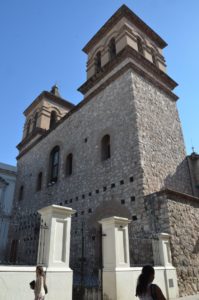
[Audioguide]
Preceded by the atrium, the two-tower facade presents three processional doors. The central door gave access to the nave, the door on the left to the University and the door on the right to the Chapel for the Natives.
The prominent external feature is the two bell towers. The facade is usually the most ornate part of the exterior of the building but in this case the walls were left uncovered. This allows us to observe a number of holes arranged around the three doors.
2 – B. Vault
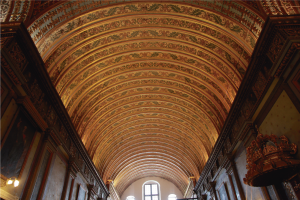
[Audioguide]
After joining the Society of Jesus, Flemish shipbuilder Philippe Lemaire SJ. was commissioned with the barrel vault. He used his naval construction skills and the Architecture treaty by Philibert de L’Orme (Nouvelles Inventions pour bien bastir et a petits frais) to produce this dramatic vault entirely from timber. It consists of a continuous series of semi cylindrical arches. The wood planks between the gilded arches were painted with leaf motifs.
2 – C. Frieze
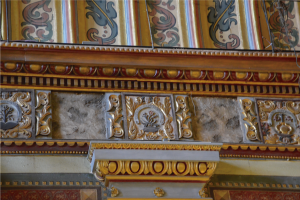
[Audioguide]
This long, narrow and horizontal band is found below the cornice. It consists of a series of portraits of Jesuit martyrs alternated with sacred emblems. The latter are square boards carved, polychrome and gilded to represent theological virtues and psalms as symbols.
2 – D. Pulpit
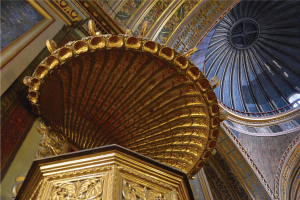
[Audioguide]
In the past, the priest used this elevated and enclosed platform to deliver the sermon. It is erected on the left pillar, near the crossing and it is executed from elaborately carved and gilded wood. The octogonal cup is reached by a short flight of stairs and the crown shaped tester (canopy) above it serves as a decorative sounding board.
2 – E. Retable
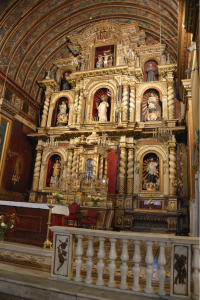
[Audioguide]
Giuseppe Brassanelli, an Italian Jesuit executed the main altarpiece in the Guarani missions. Following Bernini’s tradition, this large panel formed by three columns and three levels had a stagelike design, merging painting, sculpture and florid ornaments. In the 19th Century the original paintings were replaced by statues. At eye level we observe two of the founders of the Society of Jesus: Saint Ignatius of Loyola on the left and Saint Francis Xavier on the right.
2 – F. Chapel of Lourdes
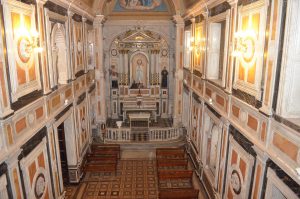
[Audioguide]
This side chapel was known in the colonial period as “The Native’s Chapel”. It was dedicated to the instruction of the enslaved Africans in the Christian principles (catechesis). The Chapel was richly ornate, presenting also a polychrome vault and a small altarpiece dedicated to Our Lady of Candelaria (Candlemas)
The decorations we observe today correspond to the return of the Society of Jesus to Cordoba in the 19th century. In 1877, Father Caietanus Carlucci SJ worked with Italian immigrants in the restoration of the Chapel. Its walls are decorated with natural marble panels and the barrel vault presents a painting that represents the apparition of Maria at Lourdes in 1858.
